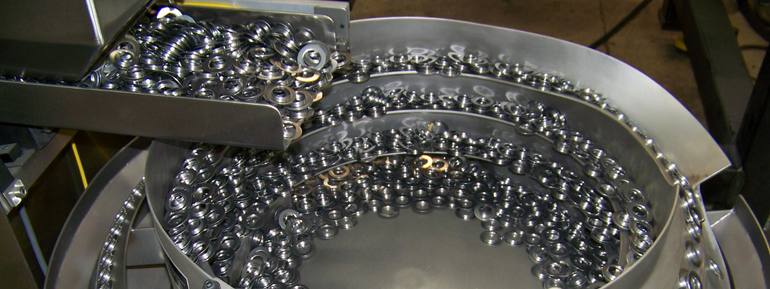Vibratory feeders appeal to many applications, however there are some that prove to be more troublesome than others. At Hoosier Feeder Company, we like to ask questions up-front to fully understand the application and easily avoid total project failure (i.e. building the feeder and system to find out that it does not work). When we consider project failure, realistically, it comes down to how seamlessly our system is integrated into our customers production line. You, our customer, can take steps along with us here at Hoosier Feeder Company to ensure your new feeder system easily adds value to your automation project.


Here are a few reasons why vibratory feeders fail in the field:
Uneven, unlevel , or cracked floor beneath the feeder system
- In our facility we build all of our feeders on even and solid concrete floors so that we have a predictable platform to tune the feeder to. The frequencies produced by the feeder resonate through the frame of the feeder’s support structure and are absorbed through the floor. When one or more of the feet or anchors is on a piece of cracked concrete, the feeder’s performance can be unpredictable at best. Make sure you understand where the feeder will be installed and if special precautions are necessary.
Improper vibration dampening/isolation
- Vibratory feeders produce a powerful vibration so we take steps to limit unwanted frequencies transferring to other components of your system. When beginning a job it is important for us to know whether or not you intend to solidly anchor the system to the ground, or if our standard leveling feet will suit your needs as a solidly anchored system will transfer vibration differently. Additionally, a standalone vibratory feeder is designed to be just that, separate from other machines. Vibration travels through the support structures and can negatively impact neighboring machines and the feeder’s performance. If you have plans to tie the feeder’s structure to an adjacent machine, let us know so we can either make the appropriate accommodations or advise an alternate plan.
Dirty, imperfect, varying parts
- One of the most important parts of a successful vibratory feeder project is the ability to provide us with the exact part, in the exact state in which it will be loaded into the feeder. Sometimes small changes in the part produce large changes in feeder performance. Take care to communicate mold release coatings and lubricants that might be left on the parts, as well as different part manufactures and part colors as both have historically produced different reactions from the feeder system. The more we know about the state(s) of parts entering the feeder before we build it, the better.
Incompatible sensors
- If sensors are necessary for you application, it is important for us to know the style whether it is NPN (sink) or PNP (source). A quick way for a project to turn sour is to have the complete unit in your facility only to find out the sensors on your new feeder cannot communicate with rest of your system.
Wandering maintenance hands and quick fixes
- Vibratory feeders are completely custom machines, so any maintenance that needs to be done should be carried out only by experienced bowl builders or personnel educated in proper maintenance. Small changes to the bowl’s tooling features and settings can have large negative impacts on the feeders performance. If there is ever any question about how to fix or tune-up a vibratory feeder, contact Hoosier Feeder Company and we can discuss the proper course of action. Additionally, take advantage of the Lock-Out feature on our standard controllers that limits access to the settings so that optimum running settings are maintained.
As always, never hesitate to reach out to us at Hoosier Feeder Company with any questions you have about pending or past feeder projects. By taking a few simple precautions, like those listed above, you can more easily ensure seamless machine integration.
February 16, 2018
Related Topics: Vibratory Feeders